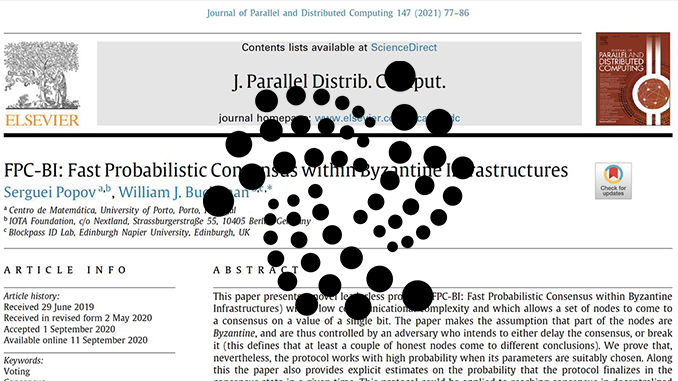
With IOTA 2.0 aka Coordicide, IOTA wants to move away from the central coordinator and finally validate transactions in the network decentrally. Now a scientific publication shows how IOTA envisions the mechanism for Coordicide.
In the world of crypto currencies, the block chain is generally the instance that neutrally decides whether a transaction is written validly. IOTA has so far chosen a special path with its central coordinator. This has proven to be an emergency brake when a serious error occurred in mid-February at the official Trinity Wallet of IOTA offered hackers an entry window. However, IOTA also wants to create trust in the future through decentralization and is therefore working on a decentralized IOTA 2.0 under the project name Coordicide. It was clear early on that the widely used protocols Proof-of-Work (PoW) and Prof-of-Stake (PoS) would hardly meet IOTA’s requirements. Now IOTA co-founder Serguei Popov and IOTA Research Councilor Dr. Bill Buchanan are demonstrating a technological solution for Coordicide.
IOTA 2.0 could score with innovation in consensus building
Popov and Buchanan titled their thesis “Fast Probabilistic Consensus within Byzantine Infrastructures”. This not only sounds complicated, but it is. We try to explain: Under probalistic, science makes statements on probability, and Byzantine is associated with the first democratic ideas and approaches to legal certainty from late antiquity. Popov and Buchanan want to prove that it makes sense to automatically give the participants of the IOTA network a level of credibility. This would enable the network to reliably fend off hostile attacks by new participants and, in normal operation, to quickly and securely establish consensus on transactions to be confirmed.
With PoW, cryptographic puzzles have to be solved before a transaction can be approved. With PoS, it is randomly selected network participants who decide. The idea for Coordicide at IOTA therefore follows its own path and aims to give preference to network participants for validation that have proven to be correct, where no suspicious decisions occur. For IOTA, the question of consensus-building is so central because the network in the Internet of Things (IoT) wants to integrate less powerful end devices and must aim for a high throughput rate. The decision as to which protocol IOTA 2.0 will ultimately implement is almost a philosophical discussion, as demonstrated by contributions from developer Hans Moog or from IOTA co-founders David Sønstebø and Dominik Schiener.
The proposal by Popov and Buchanan now benefits from the fact that it has already been checked for plausibility by external experts and only then released for publication in the “Journal of Parallel and Distributed Computing”. On the other hand, the most recent progress report on IOTA 2.0 continued to call the consensus question for Coordicide unsolved. Here, the developments may have overlapped in time.
Conclusion: IOTA 2.0 – technological breakthrough or experiment?
In order to understand the scientific evidence of Popov and Buchanan, considerable expertise is required. But it seems that they have come up with a practical model for the Coordicide protocol. It could already be implemented in the second planned testnet for IOTA 2.0 called Nectar. This would also show whether the theory proves to be an innovation in everyday life. After all, no one at IOTA would want to venture an experiment if Coordicide is transferred to the Mainnet sometime in 2021 according to the current schedule.
Best place to buy Bitcoin and IOTA:

Leave a Reply